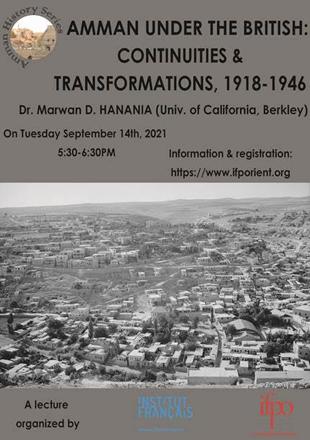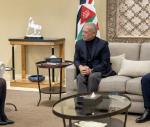You are here
Amman’s migrant communities under British rule ‘put more weight into social development than ethnic fervour’ — historian
By Saeb Rawashdeh - Sep 16,2021 - Last updated at Sep 16,2021

AMMAN — Transjordan and Amman were formed as ethnically diverse communities of professionals with ties to outside, according to a Jordanian historian.
“Amman is unique in a sense that ethnic and religious divide never caused a conflict” and the ethnic groups coexisted very well in the British and later periods, noted Marwan D. Hanania, a historian of the modern Middle East.
Speaking during a lecture titled “Amman under the British: Continuities and Transformations 1918-1946”, organised by the French institute Ifpo on Tuesday, Hanania said that after WWI and the Sykes-Picot agreement, Transjordan was organised into four administrative regions: Ajloun, Balqa, Karak and Maan.
Amman at that time had a diverse population, illustrated by its governors who were Arabs from Syria, Palestine, Hijaz, the East Bank and Circassia, said Hanania.
The British chose Amman as a main centre due to its strategic location and connection to the Hijaz Railway, the scholar said.
“The Christian minority presence in Amman was more visible in the 1920s,” Hanania said, adding that many Madaba Christians travelled to Amman using the King’s Highway.
Amman was considered a centre of communication with urban centres outside of Jordan, which was not the case with Madaba, Hanania said. He noted that Muslim families from Salt, from areas outside capital and from the West Bank began to move to Amman during the British rule.
“The history of the ethno-religious groups and their leading families suggest that the British and the Hashemites provided stability, prosperity and equality for newcomers,” said Hanania.
The historian also highlighted the role of Armenians and their skills that were unique in Amman at the time. He noted that Armenians were the first photographers in Amman. Others Armenians, like Arhak Sarkasian, became Amman’s first shoemakers.
“The history of Amman after WW1 shows how despite the global conflict, the city continued to develop and flourish, and migrant communities put more weight into social development than ethnic fervour,” Hanania said.
Related Articles
AMMAN — The Great Arab Revolt is the cornerstone of Jordan’s political legitimacy, according to an Oxford University professor.During a
AMMAN — Between 1866 and 1871, Rashid Pasha, the governor of Damascus, led the first major administrative change by creating the distr
AMMAN — British colonial architecture in Jordan was the focal point of a workshop held at the Council for British Research in the Levant (CB















